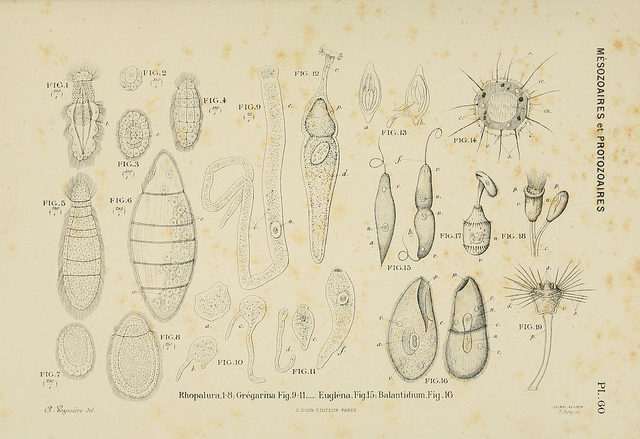 Evolution & Behaviour
Evolution & Behaviour
Human gut parasite has a sinister use for its stolen genes

It is well established knowledge that bacteria routinely exchange genes between unrelated species, creating an extensive network of information flow independent of sexual reproduction. By acquiring new genes, each being a blueprint for a single protein, the bacteria gain also the functions the proteins perform within the cell. This phenomenon is forcing itself on our attention especially with the spread of antibiotic resistance among bacteria, which is threatening our ability to fight infections. But is swapping of genes important also in more complex organisms like animals, plants, or single-celled protists? Their DNA might be better protected against change as it is enwrapped in membranes of the nucleus, but it is unclear if this barrier plays a significant role. Answers to this puzzle will have far-reaching implications both for evolutionary theories and practical understanding of diseases. The jury is still out, but new data from a human gut parasite add to the growing pile of evidence that free movement of genes is indeed happening across the whole tree of life.
Roughly one billion people worldwide have their guts infected with a microscopic sphere-shaped protist called Blastocystis which is distantly related to kelp and water molds. The parasite often goes unnoticed, but in some individuals, it manifests with severe digestive malfunctions reminiscent of the irritable bowel syndrome. A collaboration of Canadian scientists has now thoroughly sequenced and assembled the complete genetic information of Blastocystis and searched it for genes potentially stolen from other organisms, and identified 167 genes which clearly represent recent gains. Most of these genes came from bacteria, often from groups coinhabiting guts of humans and other animals together with Blastocystis, and about 20 originated from more advanced organisms, possibly past hosts of the parasite.
Blastocystis did not gain and retain the genes randomly. The researchers say that most of the genes they identified may provide a direct advantage for the parasitic lifestyle of Blastocystis. Some of them are likely involved in scavenging and utilizing nutrients which the parasite finds in the gut environment. Others may serve in evading recognition by the immune system or surviving its attacks. The newly identified genes may therefore be important for the parasite's pathogenesis, in other words, the mechanisms leading to disease. Still a lot of work has to be done before we can talk about practical utilization of this knowledge, but now we know the path. The genes which Blastocystis stole and incorporated into its own arsenal may one day provide targets for newly developed drugs, becoming an Achilles' heel of the parasite. The most promising targets are the genes which are also shared with other, unrelated, parasitic protists, since these are evidently crucial for parasitism. By targeting them, the drugs can damage the parasite's interactions with host cells and damper its ability to invade. These genes may also be safer targets because they came from organisms even more evolutionary distant from humans than the parasite itself, which means a lower risk of side effects for the patient.
Regardless of the future therapeutic applications, the study of Blastocystis and its stolen genes has already provided decisive insights into the mechanisms of biological evolution. It is becoming more and more difficult to ignore the importance of gene transfer into, and between, complex organisms endowed with a nucleus. Stolen genes clearly can benefit the recipients and help them to colonize new environments, including the environments inside a host in the case of parasites.
Original Article:
Eme L, Gentekaki E, Curtis B, Archibald J, Roger A. Lateral Gene Transfer in the Adaptation of the Anaerobic Parasite Blastocystis to the Gut. Current Biology. 2017;27(6):807-820. doi:10.1016/j.cub.2017.02.003.Next read: Lego blocks for precise gene editing by Jared Carlson-Stevermer
Edited by:
Dr. Carlos Javier Rivera-Rivera , Managing Editor
We thought you might like
GMOs are not a human invention: sweet potato is a naturally transgenic food crop
Jul 6, 2015 in Plant Biology | 3 min read by Tina KyndtA new code for a new life
May 26, 2016 in Maths, Physics & Chemistry | 3.5 min read by Jordan CostafrolazAmoebas trap bacteria using nets of DNA: the same mechanism as human immune cells
Jan 27, 2017 in Evolution & Behaviour | 3.5 min read by Lukáš NovákWhat happens to our genes in the twilight of death?
Feb 28, 2017 in Health & Physiology | 3.5 min read by Peter Noble , Alex PozhitkovMore from Evolution & Behaviour
Cicada emergence alters forest food webs
Jan 31, 2025 in Evolution & Behaviour | 3.5 min read by Martha Weiss , John LillSize does not matter: direct estimations of mutation rates in baleen whales
Jan 29, 2025 in Evolution & Behaviour | 4 min read by Marcos Suárez-MenéndezThe Claws and the Spear: New Evidence of Neanderthal-Cave Lion Interactions
Jan 22, 2025 in Evolution & Behaviour | 3.5 min read by Gabriele RussoA deep-sea spa: the key to the pearl octopus’ success
Jan 20, 2025 in Evolution & Behaviour | 3.5 min read by Jim BarryFeisty fish and birds with attitude: Why does evolution not lead to identical individuals?
Aug 31, 2024 in Evolution & Behaviour | 3 min read by Lukas Eigentler , Klaus Reinhold , David KikuchiEditor's picks
Trending now
Popular topics


